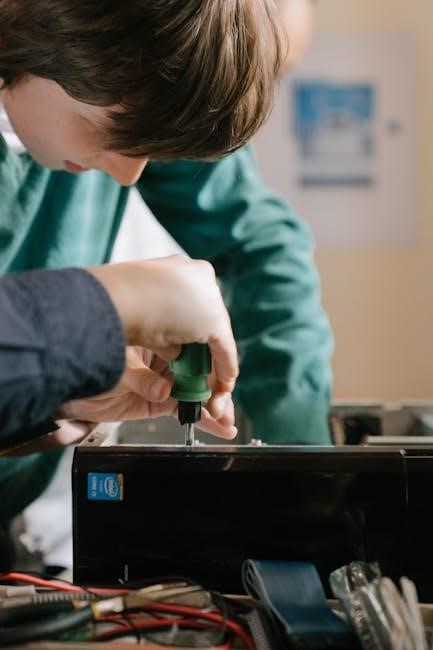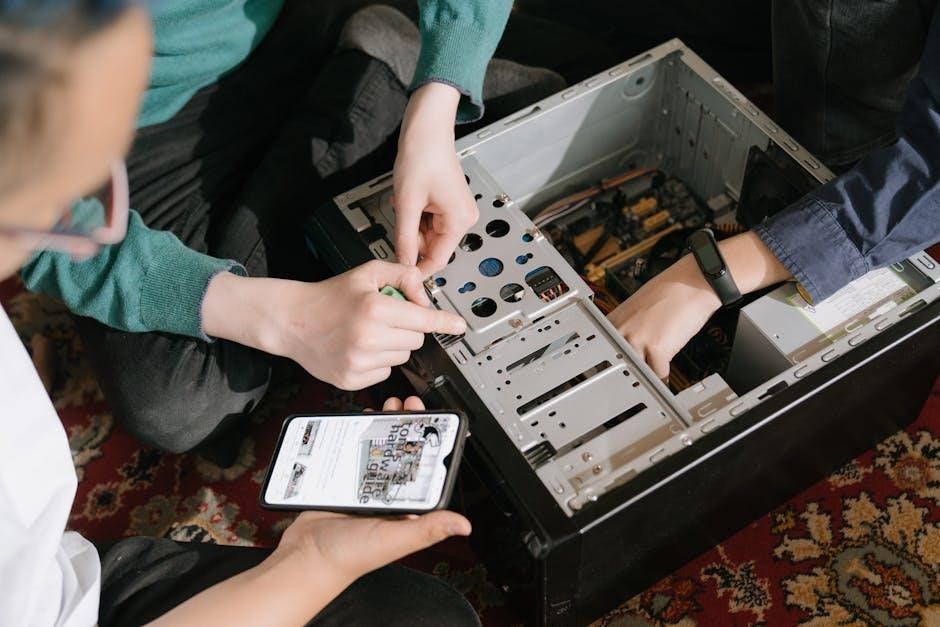A malfunctioning Amana dryer can disrupt your laundry routine, but with the right troubleshooting guide, you can identify and resolve common issues efficiently. This guide covers key problems, solutions, and maintenance tips to ensure optimal performance and extend the lifespan of your appliance.
Understanding Common Issues
Identifying common problems with your Amana dryer is the first step toward effective troubleshooting. Issues like the dryer not turning on, clothes not drying properly, or excessive noise often stem from power supply problems, clogged vents, or worn-out parts. Regular maintenance, such as cleaning the lint filter and checking vent lines, can prevent many of these issues. Understanding the root causes helps you address them efficiently, ensuring your dryer runs smoothly and safely. This guide will walk you through diagnosing and resolving these problems step-by-step.
Importance of Regular Maintenance
Regular maintenance is crucial for extending the life of your Amana dryer and ensuring efficient performance. Simple tasks like cleaning the lint filter after each use and inspecting vent lines can prevent major issues. Neglecting maintenance can lead to reduced drying efficiency, higher energy bills, and even safety hazards like fires. By incorporating routine checks and cleanings, you can avoid costly repairs and keep your dryer running safely and effectively. Consistent upkeep also helps maintain optimal drying times and prevents wear and tear on internal components.
Common Amana Dryer Problems and Solutions
Amana dryers may face issues like not turning on, clothes not drying, or excessive noise. Solutions often involve checking power supply, cleaning vents, or replacing worn parts.
Dryer Not Turning On
If your Amana dryer won’t turn on, first check the power supply. Ensure it’s properly plugged in and the outlet is functioning. Reset the circuit breaker or fuse if needed. Verify the door is closed securely, as an open door can prevent operation. Check for child lock activation, which may disable controls. If issues persist, inspect the thermal fuse or start switch for damage and replace if necessary. Always disconnect power before attempting internal repairs to ensure safety.
Clothes Not Drying Properly
Clothes not drying properly in your Amana dryer can be due to clogged lint filters, blocked vent lines, or an overloaded drum. Start by cleaning the lint filter after each use to ensure proper airflow. Check the venting system for kinks or obstructions, as restricted airflow can significantly reduce drying efficiency. Additionally, verify that the dryer is not overloaded, as this can prevent clothes from tumbling freely. If issues persist, inspect the moisture sensors for cleanliness or damage, as faulty sensors may fail to detect moisture levels accurately. Regular maintenance and proper loading can resolve most drying issues effectively.
Excessive Noise During Operation
Excessive noise during operation can be caused by loose objects in the drum, an unbalanced machine, or worn-out parts like belts or rollers. First, ensure no foreign items, such as coins or zippers, are causing the noise. If the dryer is unlevel, adjust the legs to balance it. A squeaking or grinding sound may indicate worn drum bearings or a faulty belt. Inspect the belt for cracks or frays and replace it if necessary. Lubricating moving parts or replacing worn components can restore quiet operation. Addressing these issues promptly prevents further damage and ensures smooth functionality.

Safety Precautions for Dryer Troubleshooting
Ensuring safety is crucial when troubleshooting your Amana dryer. Always disconnect power before repairs, clean lint regularly to prevent fires, and ensure proper ventilation for safe operation.
Disconnecting Power Before Repairs
Disconnecting power before repairs is essential for safety. Unplug the dryer from the electrical outlet to prevent accidental start-ups or electrical shocks. This step ensures your safety while working on internal components. Always verify that the dryer is completely powered off before beginning any troubleshooting or repair tasks. Neglecting this precaution could lead to dangerous situations. Additionally, cleaning lint and ensuring proper ventilation are critical for fire prevention and efficient operation. Always prioritize safety to avoid hazards and maintain optimal dryer performance over time.
Avoiding Fires: Cleaning Lint and Vents
Cleaning lint and vents is crucial for fire prevention. Lint buildup in filters or vents can ignite, causing dangerous fires. Regularly clean the lint filter after each use and inspect the venting system for blockages. Annual professional cleaning of dryer vents is recommended to remove accumulated debris. Faulty or clogged vents can overheat, increasing fire risks. Use rigid metal ducts instead of flammable materials for safer ventilation. Always ensure vents lead directly outdoors to maintain proper airflow and reduce fire hazards. Regular maintenance is key to preventing fires and ensuring efficient dryer operation.

Maintenance Tips to Prevent Future Issues
Regularly check and replace worn belts, inspect vent connections, and ensure proper dryer installation. Clean filters after each use and monitor for unusual noises to prevent breakdowns.
Cleaning the Lint Filter
Cleaning the lint filter is essential for maintaining your Amana dryer’s efficiency and safety. After each use, remove the filter and pull off visible lint. For deeper cleaning, wash it with mild soap and dry thoroughly before reinstalling. This simple step prevents fires, improves airflow, and ensures proper drying. Regular maintenance like this can extend the dryer’s lifespan. Always check for blockages and ensure the filter fits securely to maintain optimal performance and prevent potential hazards. Consistency in this practice will keep your dryer running smoothly for years.
Inspecting and Cleaning Vent Lines
Inspecting and cleaning vent lines is crucial for your Amana dryer’s performance and safety. Over time, lint and debris accumulate, restricting airflow and increasing fire risks. Start by disconnecting the vent from the dryer and exterior vent. Use a brush or vacuum to remove blockages. Check for kinks or damage in the venting and replace if necessary. Ensure all connections are secure to prevent leaks. Regular cleaning improves efficiency, reduces drying times, and minimizes the risk of fires. This simple maintenance task can significantly extend the life of your dryer and ensure it operates safely and effectively. Always prioritize vent health for optimal performance.

Understanding Error Codes on Amana Dryers
Amana dryers display error codes to indicate specific issues, helping you diagnose problems quickly. These codes guide you through troubleshooting steps to restore proper function efficiently.
Common Error Codes and Their Meanings
Amana dryers use specific error codes to signal issues. For example, E1 often indicates a problem with the temperature sensor, while E2 may point to a faulty door switch. E3 could signify a malfunctioning heating element, and E4 might relate to issues with the moisture-sensing bar. Understanding these codes helps you identify the root cause of the problem. Always refer to your user manual for precise code meanings, as they can vary slightly by model. Addressing these issues promptly can prevent further damage and ensure your dryer operates safely and efficiently.
How to Reset Your Amana Dryer
Resetting your Amana dryer can resolve issues like non-starting cycles or unresponsive controls. To reset, unplug the dryer from power for 10-15 minutes to clear any temporary glitches. Plug it back in and select a “No Heat” cycle, then start and stop the dryer to reset the controls. If the issue persists, check for error codes or consult the user manual for model-specific instructions. Resetting is a simple first step before moving on to more complex troubleshooting or professional repair.

DIY Repair vs. Professional Assistance
Deciding between DIY repairs and professional help for your Amana dryer depends on the issue’s complexity. Simple fixes like cleaning vents or replacing fuses are DIY-friendly, saving time and money. However, complex problems like electrical faults or motor issues require expert intervention to avoid safety risks and ensure long-term effectiveness. Balancing your skill level and the problem’s severity is key to making the right choice for reliable and safe dryer operation.
When to Attempt DIY Fixes
DIY repairs are ideal for minor issues like cleaning lint filters, checking power supply, or replacing worn-out belts. If the problem is straightforward, such as a clogged vent or a faulty fuse, you can often resolve it with basic tools. However, always prioritize safety by disconnecting power before starting any repair. DIY fixes are cost-effective and can save time, but they require some mechanical aptitude. Start with simple solutions and only proceed if you’re confident in your abilities. Complex issues like electronic malfunctions or motor problems typically require professional expertise to avoid further damage or safety hazards. Always refer to your user manual for guidance and ensure you have the necessary skills and tools before attempting any repair.
Knowing When to Call a Technician
If you encounter complex issues like persistent error codes, faulty thermostats, or electrical malfunctions, it’s best to consult a professional. Technicians have the expertise to diagnose and repair intricate problems safely. Additionally, if you’re unsure about a repair or lack the necessary tools, seeking professional help prevents further damage or safety risks. Don’t hesitate to call a technician for issues beyond basic troubleshooting, especially when dealing with internal components or gas-powered dryers. Their experience ensures efficient and reliable solutions, saving you time and potential hazards. Always prioritize safety and appliance longevity by seeking expert assistance when needed.
Preventive Measures for Optimal Performance
Regular maintenance is crucial for extending your Amana dryer’s lifespan. Cleaning lint filters and vents ensures proper airflow, reducing fire risks and enhancing efficiency. Schedule annual professional inspections to identify potential issues early. Additionally, monitoring for unusual noises or performance changes can prevent major repairs. By adopting these preventive habits, you maintain optimal dryer functionality and safety, saving time and money in the long run. Consistent upkeep ensures your appliance runs smoothly and reliably for years to come. Always stay proactive to avoid unexpected breakdowns and keep your dryer performing at its best.
Ensuring Proper Ventilation
Proper ventilation is vital for your Amana dryer’s efficiency and safety. Regularly clean the lint filter after each use to prevent buildup, which can block airflow and reduce performance. Check the venting system for kinks, damage, or obstructions, as restricted airflow can lead to longer drying times and increased energy consumption. Consider installing a venting system that meets Amana’s specifications to ensure optimal airflow. Additionally, annual professional cleaning of the dryer vent can prevent lint accumulation and reduce the risk of fires. By maintaining clear ventilation, you enhance your dryer’s performance and safety.
Monitoring for Wear and Tear
Regularly inspecting your Amana dryer for wear and tear is crucial for maintaining its performance and longevity. Check the drum for cracks or rust, and ensure the door seals are tight to prevent heat escape. Inspect the belt for signs of fraying or misalignment, as a damaged belt can cause the drum to stop turning. Additionally, monitor the dryer’s exterior for dents or damage that could affect airflow. By addressing wear and tear promptly, you can prevent minor issues from escalating into costly repairs and ensure your dryer operates safely and efficiently. Regular inspections are key to extending its lifespan.
By following this guide, you can effectively troubleshoot and maintain your Amana dryer, ensuring reliable performance and extending its lifespan. Regular maintenance and prompt repairs will help prevent major issues, saving time and money. Armed with these tips, you’ll keep your dryer running smoothly for years to come, making your laundry routine hassle-free and efficient.
Final Tips for Long-Lasting Dryer Performance
Regularly cleaning the lint filter and dryer vent is crucial for optimal performance and safety; Ensure proper ventilation by checking vent connections and avoiding kinks. Monitor for wear and tear on belts and seals, replacing them as needed. Avoid overloading the dryer, as this can strain the motor and reduce efficiency. Schedule annual professional inspections to catch hidden issues early. By following these tips, you’ll extend the life of your Amana dryer and maintain reliable operation. Consistent maintenance ensures your appliance runs efficiently and safely for years.
